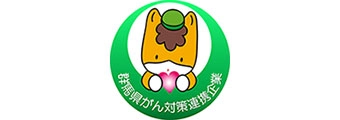TAIYO YUDEN Group, through the pursuit of creating the workplace where the employees can work with a sound mind in a sound body, has been increasing the vitality and productivity of the company, in order to realize much higher corporate value.
TAIYO YUDEN Group: Health-Oriented Management Declaration
As one of the principles comprising our Management Philosophy, we uphold "Employee Well-being", to promote the physical and mental health of employees as the management issue with the purpose of letting every employee be able to work with vigor, satisfaction and fully demonstrate their unique characteristics and abilities in their respective workplaces. To reach this goal, we will establish an organizational system to support employees and raise their awareness toward health promotion, thereby helping them and their families to lead fulfilling lives.
Katsuya Sase
Representative Director,
President and Chief Executive Officer
Organization for promoting Health-Oriented Management
Under the control of Representative Director, President and Chief Executive Officer, our company is creating the principles for health promotion and focused policies mainly taking the lead by Officer in Charge as Health-Oriented Management Promotor and Health-Promotion Section as Department specialized in Health Promotion. The principles and policies are examined in Health-Promotion Committee held semiannually and they are shared in the company. Each site, collaborating with its Safety and Health Committee, is promoting specific efforts based on the characteristics of the site.
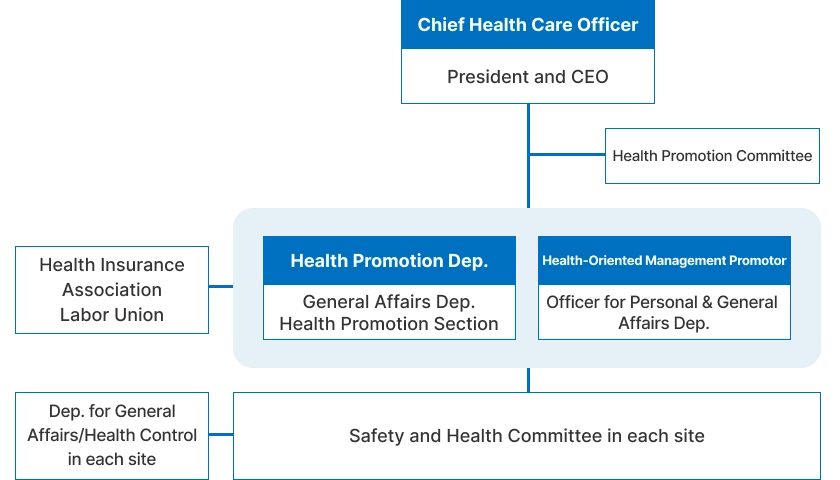
Increase more employees working with enthusiasm
~Improving Work Engagement~
One of the materialities of the Medium-term Management Plan 2025 defines "safety, health-oriented management, and work style reform" as key social issues. In particular, as part of efforts to promote health-oriented management, we endeavor to boost the energy and enthusiasm of employees, using work engagement as a key indicator.
In order to reduce the number of employees on long-term leave and those in poor health, we have established five health indicators, "Focus 5," and are implementing initiatives to help employees acquire healthy habits.
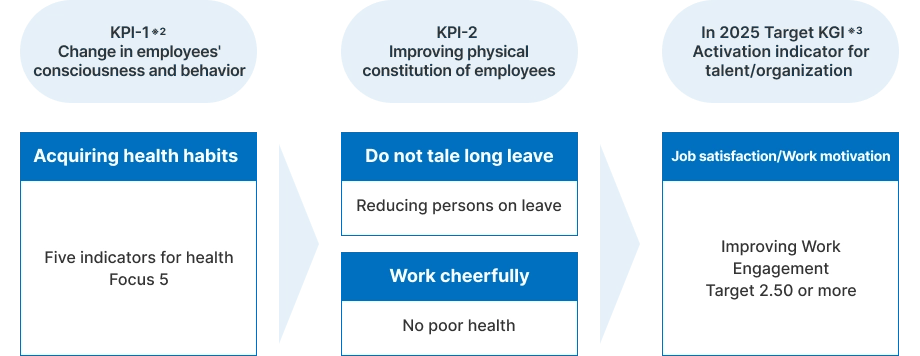
-
*1Indicator of positive and satisfying mental condition related to the work of on individual employee
-
*2Key Performance Indicator for specific process needed for achieving target
-
*3Key Goal Indicator for evaluating ultimate target on regular quantity
Indicators and Targets for Health Promotion (TAIYO YUDEN)
We have set five indicators, "Focus 5," and are promoting measures to increase the number of employees who have acquired good lifestyle habits.
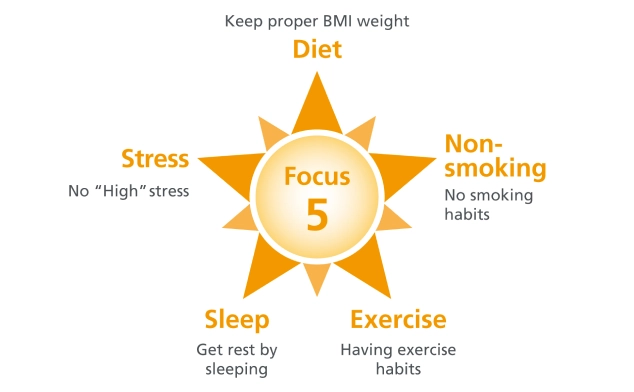
| Definition | Target | FY2024 | |
|---|---|---|---|
| Diet | Ratio of employees with BMI 18.5 or more and less than 25 | 65.3% | 64.4% |
| Non-smoking | Ratio of employees with no smoking habits | 83.3% | 83.4% |
| Exercise | Ratio of employees with exercise habits | 28.7% | 28.2% |
| Sleep | Ratio of employees able to take enough rest by sleeping | 78.3% | 60.4% |
| Stress | Ratio of employees not applied for "High stress" | 86.3% | 84.2% |
Focus 5 and Health Date (FY2024)
The correlation between the Focus 5 indicators and data on health showed that the higher the number of applicable indicators, the less abnormalities during health examination and the less ill health during stress checks.
Number of applicable Health Examination Result and Focus 5

Number of applicable Physical examination results from stress checks and Focus 5
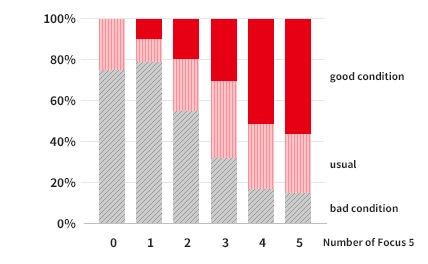
Implemented measures (FY2024)
| Indicator | Main measures | Implementation status, etc. |
|---|---|---|
| Meals |
|
|
| Non-smoking |
|
|
| Exercise |
|
|
| Sleep |
|
|
| Stress |
|
|
| Others |
|
|
Health-Oriented Management
| Item | FY2022 | FY2023 | FY2024 | |
|---|---|---|---|---|
| Work Engagement*1 | 2.28 | 2.30 | 2.28 | |
| Higher is preferable | Regular Health Check Rate | 100.0% | 100.0% | 100.0% |
| Varied special health check Rate | 100.0% | 100.0% | 100.0% | |
| Rate of receiving detailed examinations after regular health check-ups | - | - | 58.3% | |
| Control rate of hypertension patients receiving treatment | - | - | 85.7% | |
| BMI suitable (18.5 or more and less than 25) Person Ratio | 64.7% | 63.1% | 64.4% | |
| Nonsmoking Rate | 83.3% | 82.9% | 83.4% | |
| Ratio for employees with Exercise habits | 26.8% | 27.9% | 28.2% | |
| Ratio for employees able to take enough sleep | 62.1% | 60.5% | 60.4% | |
| Ratio for employees able to have motivation for improving life habits*2 | 78.9% | 79.2% | 77.2% | |
| Ratio for employees improving life habits*2 | 32.1% | 32.5% | 33.6% | |
| Ratio for taking Stress Check | 92.7% | 90.1% | 91.4% | |
| Lower is preferable | High-stress person ratio by Stress Check | 16.0% | 15.5% | 15.8% |
| Ratio for employee's conscious of bad physical condition*1 | 34.5% | 32.8% | 33.5% | |
| Presenteeism*3 | - | - | 23.3% | |
| Ratio for absenteeism (Absence due to personal injury/illness) | 0.9% | 0.9% | 1.3% | |
-
*1Cited from Brief Survey Results of New Occupational Stress
-
*2Cited from the results of the answer of Q21 in Specific Health Examination Questionnaire
-
*3The Presenteeism is calculated based on SPQ (Single-Item Presenteeism Question) using the responses obtained through stress checks. Calculation formula: 100 minus the average of the responses.
Health Promotion Initiatives
Measures Against Lifestyle-related Diseases
~Collabo-health with Health Insurance Association~
Rising risk of lifestyle-related disease and health care costs is the major challenge that cannot be avoided. Our Health Insurance Association has lowered the target age for Specific Health Check and Specific Health Guidance from the statutory age of 40 or older to 35 or older in order to encourage people to take a greater interest in their own health before the age of 40 and to prevent lifestyle-related diseases at an early stage.
For implementing Specific Insurance Guidance, nursing-job person in Health Control Room of our company is closely involved. Also, as a whole company, by cooperating with interview implementation we are making efforts to keep environmental improvement where the targeted employees are able to participate inside the company. Having efforts as background, as for Specific Insurance Guidance, implementation ratio of our company is greatly exceeding 55.0% required by the country.
TAIYO YUDEN Health Insurance Activity (FY2023)
Target: TAIYO YUDEN employees aged 40 and over in Japan
| 1. Implementation rate of specific health checkups | 99.6% |
|---|---|
| 2. Implementation rate of specific health guidance | 70.4% |
| 3. Percentage of people eligible for specific health guidance | 19.5% |
- Data source
-
-
1,2.Health Scoring Report for FY2023 (Results for FY2022) Taiyo Yuden Co., Ltd.
(Ministry of Health, Labor and Welfare. Nippon Kenko Kaigi. Ministry of Economy, Trade and Industry) -
1,2,3.Health Analysis Report 2023 Taiyo Yuden Co., Ltd.
(Taiyo Yuden Health Insurance)
-
Measures Against Mental Health
~Follow-up After Implementing Stress Check
Our company is regarding the employees applied to "High Stress Person" and also not to hope to take interview guidance by doctor as "High Risk Person" to have them supported. For High Risk Person as target person for normal insurance guidance, nursing-job person in Health Control Room will make a contact. In the case of hoping to have insurance guidance, nursing-job person will make interview based on the situation and give guidance for counseling or a series of interview on a regular (irregular) basis. For High Risk Person making efforts to confirm work-site environment and current physical condition.
Smoking Countermeasures
~Promotion by Collaboration with Health Insurance Association~
According to strengthening laws for passive smoking and Health-Oriented Management Declaration of our company, we are promoting smoking countermeasures in cooperation with Health Insurance Association from 2019. Arranging environment maintenance team for smoking site, public awareness team for making employees informed or have awareness, and quit-smoking team for conducting follow-up for the persons hoping to quit smoking, and setting the first goal as "No smoking in the site all day", we have been promoting activities with domestic group companies.
We had made step-by-step promotion: Prohibiting cigarette sales from vending machine, enlightenment events in honor of World No-Tobacco Day, installing banners and displaying no-smoking poster, holding no-smoking seminar, distributing leaflets in the place of Regular Health Check, lending books related to no smoking, no-smoking support with incentive, and reached the goal of "No smoking in the site all day" from April, 2021 as planned.
At present, for Enforcement and continuous maintenance of rules, we are conducting regular site patrol and making result reporting to Safety and Health Committee and quit-smoking support. The smoking rate in FY2024 was 16.6%, while it was 23.4% in fiscal 2019.
Acquisition of Certification (TAIYO YUDEN)
White 500 for Outstanding Health and Productivity Management
We have been acknowledged for 5 consecutive years since 2021 by Japan’s Ministry of Economy, Trade and Industry in its Health and Productivity Management Organization Recognition Program for our strenuous efforts toward overcoming regional health-related challenges and promoting health-conscious activities led by the Nippon Kenko Kaigi.

Sports Yell Company
We were certified as a Sports Yell Company for 5 consecutive years since 2021 by the Japan Sports Agency in recognition of our wide-ranging activities for encouraging employees to engage in exercise and sports.
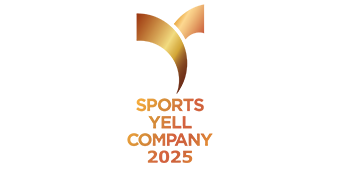
Gunma Prefecture's Partner Company for Cancer Prevention and Control
In 2021, we were certified by the Gunma prefectural government for our efforts on cancer prevention and control, particularly for raising awareness in the workplace of the importance of undergoing cancer screening tests and incentivizing employees to do so, as well as for creating an environment to enable employees with cancer to continue working while receiving treatment.
